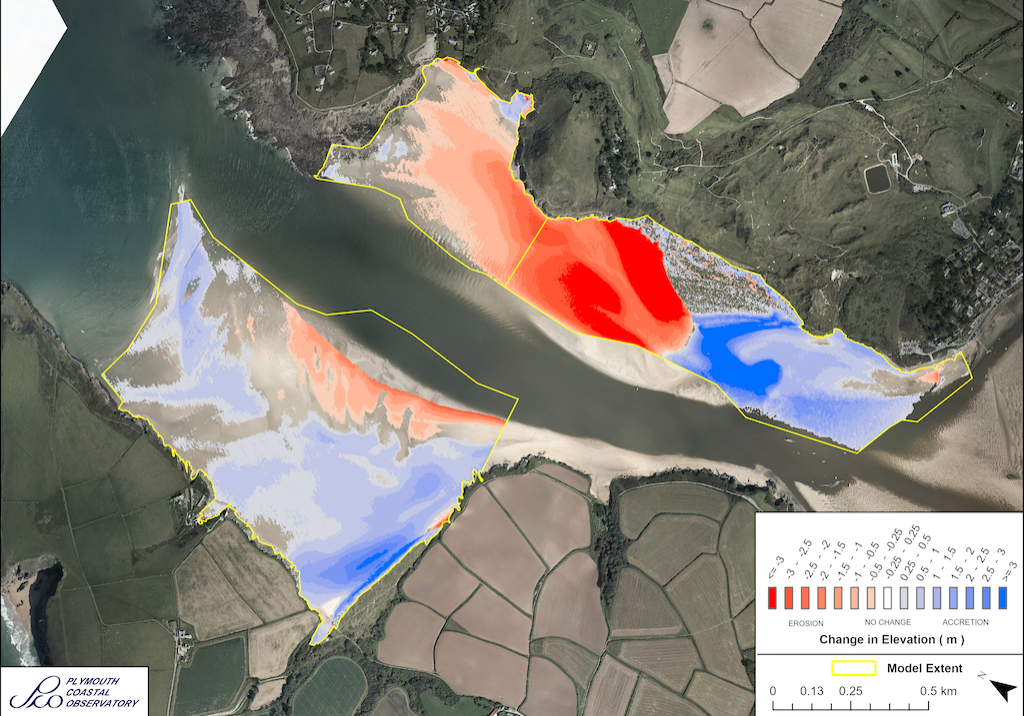
Hawkers Cove/Harbour Cove is home to a north facing estuarine dune system, in the mouth of the River Camel. Hawkers Cove is influenced not only by the ebb and flow of the tide but is also influenced by the constant flow of the River Camel. The amount of energy within the Camel Estuary means that sediment movement can be significant, resulting in dunes associated with the site building, and potentially eroding, over a relatively short period of time.
At highwater the beach associated with Hawkers Cove is narrow, but as the tide drops, the sands of the estuary are exposed, linking the smaller coves on the western side of the Camel Estuary. This fine sand also forms the famous Doom Bar, which presents a navigational challenge to any vessels traveling in the estuary.
Harbour Cove is separated from the busy town of Padstow by a network of fields, so despite its proximity to the town, it remains a relatively quiet rural beach. With the exception of the coastguard cottages and the old lifeboat house of Hawkers Cove, the location remains undeveloped. The building, eroding or rollback of the dunes at Harbour Cove will only impact those fields located directly behind it.


Coastal Change
The coastline of Cornwall is an ever-changing environment. It is energetic, dynamic, never still and changes with each wave and each tidal cycle. Some of the changes we see are gradual and barely noticeable, whilst others, such as rockfalls, happen suddenly and often shockingly.
From one visit to the next it can sometimes be difficult to see how a beach and dune system has changed, but information has been collected, and is being collected through the Making Space for Sand project, to help us better understand how the coastline is changing. The purpose of this section of the website is to understand each location has changed over time, how it could change in the future and understand the policies that influence how we can respond to these changes.
Shoreline Management Plans (SMP)
The Shoreline Management Plan (SMP) is a strategic planning and management assessment tool that helps identify and measure the risk associated coastal erosion and coastal flooding. The document makes a number of policy recommendations over short, medium and long term timeframes setting out a strategic approach to managing the built, natural and historic environments associated with the coastline. Within SMP there are four policy approaches which have been assigned to stretches of coastlines. The four policies are: No Active Intervention (NAI), Hold the Line (HTL), Managed realignment (MR), and Advance the line (ATL).
Hawkers Cove sits within Policy Development Zone 14 (PDZ14), in Management Area 35 (MA35), within Policy Unit (PU) 35.1. The policy recommendations for this policy unit are detailed in the table below and the SMP can be accessed through the Cornwall Council website.
Use your touchscreen
to scroll the below table
| Policy Unit | SMP2 Policy Plan | ||||
| 2025 | 2055 | 2105 | Comment | ||
| 35.1 | Undefended cliffs and estuary banks
Main Policy Sub Policy
|
NAI DnD |
NAI DnD |
NAI DnD |
This approach best meets the management intent of allowing the natural evolution of the coast and the objectives of the AONB and Heritage Coast designations. |
| 35.12 | Rock Dunes and Daymer Bay
Main Policy Sub Policy
|
NAI DnD
|
NAI DnD |
NAI DnD |
Policy intends to allow natural coastal evolution to support the nature and conservation values. There are no assets are risk of flooding or erosion other than a small number of Scheduled Monuments, one of which includes the Rock Ferry landing stage. This area is a popular amenity dune and beach area and in part forms the SW coast path and it is reported that since SMP policy was adopted, erosion has increased and so policy review is recommended even though not identified in SMP-R health check report.
|
| Key Main Policy: HTL - Hold the Line, A - Advance the Line, NAI – No Active Intervention, MR – Managed Realignment
Sub Policy: DnD – Do not Defend. |
|||||


National Coastal Erosion Risk Mapping (NCERM)
National Coastal Erosion Risk Mapping (NCERM) provides a baseline of coastal erosion, for the coastline of England, over short, medium and long-term timeframes. The data is based on the natural and defence characteristics of the coastline and provides rates of erosion at differing levels of confidence to help better plan for worse case scenarios. The data provided is for guidance and does not estimate the absolute location of the future coastline.
The basic NCERM lines show erosion estimates for the Short Term (ST-20 years), Medium Term (MT-50 years) and Long Term (LT- 100 years). The data is further categorised by probability: 05 is 5% probability (a 1 in 20 chance of being exceeded) Red Shading, 50 is 50% probability of being exceeded (a 1 in 2 chance of being either exceeded or not exceeded) Orange Shading and 95 is 95% probability (a 19 in 20 chance of being exceeded) Yellow Shading. Click the link below to access the Cornwall Council NCERM Mapping site read the about section then click on layers.

Modelling Coastal Change

Using data that has already been collected, combined with data collected through the Making Space for Sand project, a series of models will be carried out at each location. This will help us better understand how each location may respond to sea level rise and gain a deeper understanding of how coastal sediments move and behave.
The complexity of the modelling, and the data collection that helps inform it, means that modelling outputs will not be the same on all sites. Some locations will be more thoroughly investigated to understand more complex issues and provide data that can be more widely applied to other sites with similar characteristics.
As the project develops this section of the website will expand, sharing new reports and coastal change projections when they are produced.
LiDAR surveys, which are explained on the Data Modelling page, have been carried out by the South West Coastal Monitoring program at this location. The image shared here visualises where sand has eroded (areas shaded in red) and where it has built up (areas shaded in blue), between the LiDAR surveys carried out in 2003 and 2020. The darker the shade of red or blue the greater the amount of sand erosion or accumulation has been observed. The image helps visualise that beaches are areas that change shape over time and will continue to do so as sea levels rise.


Designations
The coastline represents an important transition between the marine environment and the terrestrial environment. This transition creates a range of special habitats and exposes a range of interesting features, which that can result in these spaces being highly designated and protected. There are a range of designations that recognise a variety of different features. At this location these designations are explored below.
Site of Special Scientific Interest (SSSI)
A Site of Special Scientific Interest or SSSI is a statutory conservation designation notified by Natural England denoting protection for biological and/or geological characteristics. The natural wildlife and geological features of SSSI’s are considered to be irreplaceable parts of the national heritage. These are protected in order to preserve their importance, and to prevent damage and development.
The Harbour Cove SSSI covers an area of 29.1 hectares between St George’s Cove and the western edge of Harbour Cove. The geology of the area contains excellent exposures of fossil rich slates, which are important for dating purposes.
Image of the mouth of the Camel Estuary
Designated Cornwall National Landscape Area
From November 2023, all areas previously know as Areas of Outstanding Natural Beauty, or AONBs, were re-named National Landscape and in Cornwall became Cornwall National Landscape. However, the Management Plan still references the term AONB as this was formally adopted by Cornwall Council and cannot be amended until the next plan is produced.
Cornwall National Landscape areas are protected landscapes whose distinctive character and natural beauty are so outstanding that it is in the nation’s interest to safeguard them. As such they have been nationally designated by the same legislation as National Parks and have the same status and level of protection.
The Carnewas to Stepper Point section covers an area of 2,365 hectares, which is 2.6% of the total Cornwall National Landscape. The key landscape characteristic of this section is the variety of coastal scenery due to the diverse geology including hard greenstones, which form the elevated headlands, the more easily eroded slates and shales that back the bays and coves between the headlands and the extensive coastal sand dunes.
Image of Bedruthan Steps
Sign up to Making Space for Sand
If you would like to get involved in helping to make dunes more resilient and biodiverse, want to help develop coastal adaptation and emergency plans or just want to know more about what the project is learning about coastal change, please click here:


